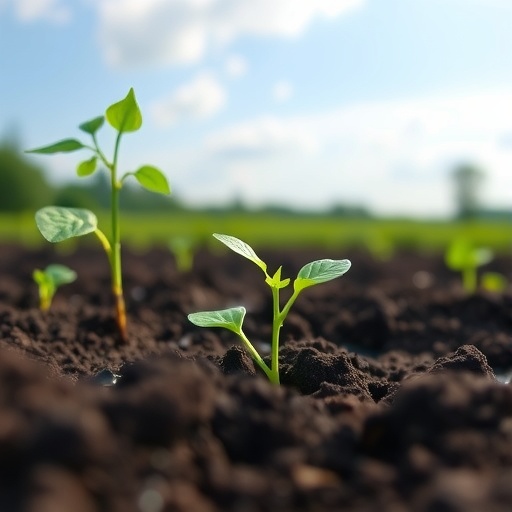In a groundbreaking study, researchers led by Wang, Y., in collaboration with Meng, C., and Chen, Q., have explored innovative techniques for immobilizing heavy metals in soil, particularly cadmium (Cd) and lead (Pb). This research provides a significant step forward in addressing soil contamination, which has become an alarming environmental issue worldwide. The study emphasizes the role of biochar—specifically polyethyleneimine (PEI)-functionalized biochar derived from agricultural residues—in mitigating pollutant mobility and bioavailability.
Heavy metal contamination poses severe risks to public health and ecosystems. Cadmium and lead are known to accumulate in the food chain, leading to serious health problems in humans, including kidney dysfunction, neurological damage, and developmental issues in children. Given the severity of these risks, the need for effective remediation strategies is more critical than ever. Traditional remediation techniques often prove expensive and environmentally damaging, driving researchers to seek more sustainable alternatives.
Biochar has emerged as a promising candidate for soil remediation due to its unique physico-chemical properties. Derived from the pyrolysis of organic materials, biochar exhibits a high surface area, porous structure, and strong sorptive capabilities, which can be harnessed to immobilize heavy metals in contaminated soils. However, the effectiveness of biochar in real-world applications can be limited by its chemical structure. This study aims to enhance biochar’s metal-sequestering abilities by functionalizing it with polyethyleneimine, a branched polyamine known for its high cationic charge density.
The research team’s methodology involved treating agricultural residues, such as corn stover and straw, to produce biochar. After the initial pyrolysis, the biochar underwent a chemical modification process using PEI to increase its affinity for heavy metals. The resulting PEI-functionalized biochar was then subjected to extensive laboratory testing to evaluate its effectiveness in immobilizing both cadmium and lead in soil samples.
Initial findings revealed that the PEI-functionalization significantly improved the biochar’s sorption capabilities. Experimental results demonstrated that the modified biochar effectively reduced the mobility of cadmium and lead in contaminated soil, showing a notable decrease in the available concentrations of these metals. This suggests that the incorporation of PEI not only enhances heavy metal binding but also alters the chemical forms of metals in the soil, rendering them less bioavailable to plants and microorganisms.
Additionally, the team conducted leaching experiments to assess the long-term stability of the heavy metal immobilization. Results indicated that soils treated with PEI-functionalized biochar exhibited minimal leaching of cadmium and lead, which is critical for ensuring sustained remediation effects over time. This finding emphasizes the potential for this innovative biochar treatment approach to provide a lasting solution for soil contamination issues.
The researchers also examined the influence of various environmental factors on the immobilization process, including pH and organic matter content. They discovered that the effectiveness of the PEI-modified biochar was significantly affected by these factors, highlighting the importance of site-specific assessments for optimizing remediation strategies. Such findings underscore the necessity for ongoing research to tailor biochar treatments to specific environmental conditions and contaminants.
This study not only fills a crucial knowledge gap in the field of environmental science but also opens doors for future advances in biochar applications. The concept of using agricultural waste to produce functionalized biochar presents an opportunity for waste valorization and sustainable land management. By transforming agricultural residues into a valuable resource for soil remediation, researchers are paving the way towards a circular economy.
The implications of this research extend beyond agricultural practices and into urban environments where soil contamination is prevalent. As cities grow, so does the risk of soil degradation and the accumulation of heavy metals. The application of PEI-functionalized biochar could serve as a viable strategy for urban soil remediation, contributing to healthier and more sustainable urban ecosystems.
Furthermore, this innovative approach aligns with global environmental goals, including those aimed at sustainable development and pollution reduction. By adopting such eco-friendly methods for combating soil contamination, communities can actively engage in preserving their environment and promoting public health.
Moving forward, the research team plans additional field trials to assess the effectiveness of PEI-functionalized biochar under real-world conditions. They intend to collaborate with local agricultural producers to implement this technique in affected areas, further bridging the gap between laboratory research and practical application. This collaborative approach will also facilitate the gathering of data on the long-term impacts of biochar treatments on soil health and crop production.
In conclusion, the study led by Wang et al. represents a significant advance in understanding how biochar can be enhanced for effective soil remediation. The innovative use of PEI-functionalization opens up new possibilities in managing soil contamination, a critical concern for sustainable ecological practices. As the implications of their findings unfold, this research highlights the urgent need for continued exploration in the fields of environmental science and sustainable agriculture. By addressing heavy metal contamination with novel techniques, we can foster a healthier planet for future generations.
Subject of Research: Soil Contamination and Remediation
Article Title: Immobilization of Cd and Pb in soil using PEI (polyethyleneimine)-functionalization biochar derived from agricultural residues.
Article References:
Wang, Y., Meng, C., Chen, Q. et al. Immobilization of Cd and Pb in soil using PEI (polyethyleneimine)-functionalization biochar derived from agricultural residues. Environ Monit Assess 197, 1103 (2025). https://doi.org/10.1007/s10661-025-14563-9
Image Credits: AI Generated
DOI: 10.1007/s10661-025-14563-9
Keywords: Biochar, Heavy Metals, Soil Remediation, PEI Functionalization, Cadmium, Lead, Agricultural Residues, Environmental Science.




